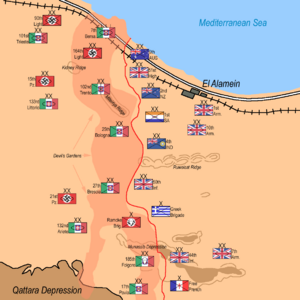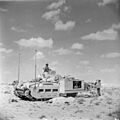Devil's gardens facts for kids
The Devil's gardens was a scary name given to a huge area filled with land mines and barbed wire. These dangerous traps were set up by German and Italian forces during World War II in late 1942. They were built to protect their positions at a place called El Alamein in Egypt.
The name "Devil's gardens" was first used by Erwin Rommel, a famous German general. These defenses stretched a long way, from the Mediterranean Sea all the way to the Qattara Depression, a large desert basin. Even today, millions of mines from the world wars are still buried there. They make it hard for people to build and develop the land in the Matrouh area of Egypt.
Contents
What Were the Devil's Gardens?
The Devil's gardens were not pretty flower beds. Instead, they were deadly fields of hidden explosives. These areas were designed to stop enemy soldiers and tanks from moving forward. They were a major challenge for the British forces trying to attack.
How Many Mines Were There?
It's hard to know the exact number, but it's thought that around 16 million mines were planted in the wider area over time. Before the big battle at El Alamein, about 3 million mines were laid. Many of these mines are still there today. They are becoming even more dangerous as time passes because they can become unstable.
Clearing the Dangerous Paths
During the battle, the British Eighth Army needed to get through these minefields. Their commander, Lieutenant General Bernard Montgomery, had a plan. Engineers, who are like military builders, were tasked with clearing safe paths.
How Were Mines Cleared?
The engineers, supported by soldiers from the 2nd New Zealand Division, used different methods. They often used hand tools to carefully find and remove the mines. They also tried using special tanks called Scorpion tanks. These tanks had spinning chains on the front that would hit the ground and explode anti-tank mines safely.
However, the Scorpion tanks didn't work as well as hoped. This meant that most of the mine clearing had to be done by hand. This was a very difficult and risky job for the soldiers. Luckily, most of the mines were anti-tank mines, which are designed to stop vehicles. If there had been more anti-personnel mines, which hurt people, the job would have been even harder and more dangerous.
Images for kids



